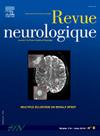留尼汪岛峡谷脑白质病的临床表现及自然病史
IF 2.3
4区 医学
Q2 CLINICAL NEUROLOGY
引用次数: 0
摘要
谷状白质脑病(RLE)是一种遗传性常染色体隐性遗传病,具有典型的临床和放射学征象,迄今为止仅在复发性患者中观察到。RAVINE这个词是法语首字母缩略词,代表了这种疾病的主要临床特征:抑郁、厌食症、无法控制的呕吐、神经性症状(呕吐、厌食症、难治性呕吐、神经性症状)。RLE患者携带SLC7A2基因纯合子状态的IVS1-1778A>;G突变。在这里,我们提出了第一个完整的临床描述和RLE的自然史。材料与方法回顾性分析所有团聚父母所生疑似RLE患者的病历。通过检测SLC7A2基因纯合突变IVS1-1178A>;G,证实了RLE的诊断。回顾性分析遗传证实的RLE患者的临床和临床旁资料,以确定该疾病的临床表现和自然病史。结果我们回顾性分析了40例遗传确诊的RLE患者的临床和临床旁资料,根据症状的演变区分出3种类型。症状分为4个发展阶段:A期,或类似消化期,以消化症状和较小程度的神经症状为特征;B期,或临床潜伏期;C期,或加重期,以神经症状发作为特征;D阶段,即衰退阶段,其特征是丧失行走能力并逐渐走向死亡。I型RLE(37.5%)或单相RLE患者仅经历严重的a期,死亡发生在28个月前,时间窗非常窄(23.0±2.2个月)。II型RLE患者(16.7%)或双期RLE患者直接从A期进入d期。III型RLE患者(45.8%)或多期RLE患者经历了所有4期,症状严重程度不同。这是最常见的RLE类型。中枢性呼吸暂停和声带麻痹在A期的联合出现提示预后不良。皮质类固醇治疗似乎在A期有效,在某些情况下在c期有效。讨论本回顾性研究提供了RLE的第一个完整的临床描述和自然史。根据症状的演变将该病分为三种类型。RLE的诊断可以在留尼旺岛以外建立,因为许多留尼旺夫妇已经移民到世界其他地方。本文章由计算机程序翻译,如有差异,请以英文原文为准。
Clinical presentation and natural history of RAVINE leukoencephalopathy in Reunion Island
Introduction
RAVINE leukoencephalopathy (RLE) is a hereditary autosomal recessive disease characterized by typical clinical and radiological signs that has so far been observed only in patients of Reunionese origin. The term RAVINE is a French acronym for the main clinical features of the disease: Réunion, Anorexie, Vomissements Incoercibles, signes NEurologiques (Reunion, Anorexia, Intractable Vomiting, NEurological signs). Patients with RLE carry the IVS1-1778A>G mutation of the SLC7A2 gene in the homozygous state. Here we present the first complete clinical description and natural history of RLE.
Material and methods
The medical records of all patients born to Reunionese parents and presenting with suspected RLE were reviewed. The diagnosis of RLE was confirmed by detection of the homozygous mutation IVS1-1178A>G of the SLC7A2 gene. The clinical and paraclinical data of patients with genetically confirmed RLE were retrospectively analyzed to determine the clinical presentation and natural history of the disease.
Results
Our retrospective analysis of the clinical and paraclinical data of 40 patients with genetically confirmed RLE distinguished 3 types of the disease based on the evolution of symptoms. Symptoms were classified into 4 stages of development: stage A, or digestive-like stage, characterized by digestive symptoms and to a lesser extent by neurological symptoms; stage B, or clinically latent stage; stage C, or exacerbation stage, marked by attacks of neurological symptoms; and stage D, or decline stage, characterized by loss of walking ability and progression towards death. Patients with type I RLE (37.5%), or monophasic RLE, experience only the severe stage A. Death occurs before the age of 28 months in a very narrow time window (23.0 ± 2.2 months). Patients with type II RLE (16.7%), or biphasic RLE, move directly from stage A to stage D. Patients with type III RLE (45.8%), or multiphasic RLE, experience all 4 stages with varying degrees of symptom severity. This is the most frequent type of RLE. The joint occurrence of central apnea and vocal cord paralysis during stage A is indicative of unfavorable prognosis. Corticosteroid therapy seems to be effective during stage A and in some cases during stage C.
Discussion
This retrospective study provides the first complete clinical description and natural history of RLE. Three types of the disease were distinguished based on the evolution of symptoms. The diagnosis of RLE can be established outside of Reunion Island as many Reunionese couples have emigrated to other parts of the world.
求助全文
通过发布文献求助,成功后即可免费获取论文全文。
去求助
来源期刊

Revue neurologique
医学-临床神经学
CiteScore
4.80
自引率
0.00%
发文量
598
审稿时长
55 days
期刊介绍:
The first issue of the Revue Neurologique, featuring an original article by Jean-Martin Charcot, was published on February 28th, 1893. Six years later, the French Society of Neurology (SFN) adopted this journal as its official publication in the year of its foundation, 1899.
The Revue Neurologique was published throughout the 20th century without interruption and is indexed in all international databases (including Current Contents, Pubmed, Scopus). Ten annual issues provide original peer-reviewed clinical and research articles, and review articles giving up-to-date insights in all areas of neurology. The Revue Neurologique also publishes guidelines and recommendations.
The Revue Neurologique publishes original articles, brief reports, general reviews, editorials, and letters to the editor as well as correspondence concerning articles previously published in the journal in the correspondence column.
 求助内容:
求助内容: 应助结果提醒方式:
应助结果提醒方式:


